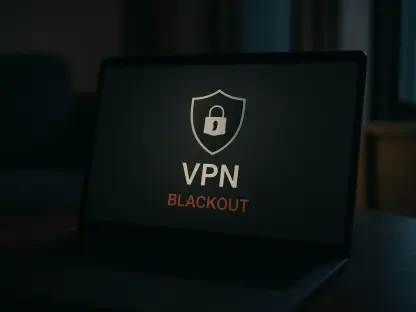Imagine a hacker sitting in a parked car outside a busy office, cracking into a secure Wi-Fi network in mere seconds using a decade-old exploit, a scenario that is not just a plot from a cyber thriller but a genuine threat known as the Pixie Dust Wi-Fi hack. First identified over ten years ago, this vulnerability in Wi-Fi Protected Setup (WPS) continues to endanger millions of devices worldwide, from home routers to critical infrastructure systems. This roundup gathers insights, warnings, and recommendations from various industry sources and security experts to explore why this outdated threat still looms large and how stakeholders can address it. The goal is to shed light on differing perspectives, highlight actionable advice, and underscore the urgency of tackling systemic security gaps.
Exploring the Roots and Reach of a Lingering Vulnerability
The Pixie Dust attack, rooted in a flaw within WPS, allows attackers to bypass network passwords by exploiting predictable PIN generation during a handshake process. Industry analyses consistently point out that an attacker within range can capture this data and crack the PIN offline in just moments. Many sources emphasize the alarming simplicity of this exploit, noting that it requires minimal technical expertise and widely available tools, making it a go-to for malicious actors targeting unsuspecting users.
Divergent views emerge on the scale of the threat across different sectors. Some cybersecurity reports focus on the risk to individual households, where unpatched routers are common due to user unawareness. Others highlight a graver concern in enterprise settings, such as retail chains or healthcare facilities, where a single breach could compromise sensitive data on a massive scale. This disparity in focus reveals a shared consensus: the vulnerability’s persistence is a universal problem, cutting across personal and professional environments with equal menace.
A recurring theme in expert discussions is the sheer number of affected devices still in circulation. Recent studies indicate that millions of routers, even those currently supported by manufacturers, lack necessary patches. This statistic fuels debates over whether the blame lies with end-users for not updating devices or with systemic failures in the tech industry. The conversation often pivots to a need for broader awareness, as many stakeholders remain unaware of the silent danger embedded in their networks.
Dissecting Vendor Responsibility and Industry Shortcomings
Delayed Responses and Patchwork Fixes
A significant point of contention among industry watchers is the slow response from device manufacturers to address the Pixie Dust flaw. Many sources report that even supported hardware often goes unpatched for years, with some models only receiving updates a decade after the vulnerability’s discovery. This delay is frequently attributed to a lack of priority given to firmware security, leaving users exposed to easily exploitable risks.
Critics also note that a substantial number of devices have reached end-of-life status, meaning they no longer receive updates at all. These outdated units remain in active use across various settings, from small businesses to branch offices, amplifying the threat landscape. Some industry voices argue that vendors should implement sunset policies to phase out unsupported hardware, while others believe the responsibility falls on users to replace obsolete equipment.
The gap between perceived and actual security adds another layer of concern. Several analyses reveal that even when user interfaces suggest WPS is disabled, underlying firmware flaws can still be exploited. This deceptive design choice frustrates security professionals who stress that superficial fixes create a false sense of safety, masking deeper vulnerabilities that attackers can readily target.
Systemic Flaws in Firmware Supply Chains
Beyond individual vendor actions, a broader critique centers on the firmware supply chain’s inherent weaknesses. Many experts highlight how manufacturers often reuse insecure software libraries, perpetuating known flaws like Pixie Dust across multiple product lines. This practice, combined with inconsistent update mechanisms, creates a patchwork of protections that fails to keep pace with evolving cyber threats.
Transparency—or the lack thereof—emerges as a critical issue in these discussions. Sources point out that vendors rarely disclose the full extent of vulnerabilities in their devices, leaving enterprises and consumers in the dark about potential risks. Some industry advocates call for standardized reporting protocols to ensure accountability, arguing that without clear communication, trust in networking hardware will continue to erode.
Differing opinions also surface on how to address these systemic gaps. While some suggest regulatory intervention to enforce firmware security standards, others propose market-driven solutions, such as incentivizing vendors to prioritize updates through consumer demand. Despite these varied approaches, there’s a unified recognition that the current state of firmware management is unsustainable, posing long-term risks to global cybersecurity.
Gathering Practical Tips to Mitigate Risks
Security professionals across the board offer actionable advice for both individuals and organizations to combat the Pixie Dust threat. A primary recommendation is to disable WPS entirely on all devices, ensuring that this feature cannot be exploited even at a firmware level. This step, though simple, is often overlooked by users unfamiliar with router settings, prompting calls for better educational resources from vendors.
Another widely endorsed tip is to prioritize hardware that receives regular firmware updates, ideally from manufacturers with a proven track record of addressing vulnerabilities promptly. For enterprises, some sources suggest conducting routine security audits to identify and replace end-of-life devices, particularly in high-stakes environments where a breach could have catastrophic consequences. This proactive stance contrasts with more reactive approaches seen in smaller setups, highlighting a divide in resource availability.
A final piece of guidance focuses on fostering dialogue between users and manufacturers. Many experts encourage consumers to demand transparency regarding device security and push for timely patches through support channels. This collective pressure, paired with internal policies to minimize reliance on outdated equipment, forms a dual strategy that several analyses deem essential for reducing exposure to silent exploits like Pixie Dust.
Reflecting on Key Takeaways and Next Steps
Looking back on the insights gathered, it becomes evident that the enduring threat of the Pixie Dust Wi-Fi hack stems from a combination of vendor inaction, hidden firmware flaws, and widespread use of unpatched devices. Discussions revealed a stark contrast between the ease of exploitation and the slow pace of industry response, while practical tips underscored the power of user initiative in bridging security gaps. The varied perspectives—from critiques of systemic failures to actionable user advice—paint a comprehensive picture of a challenge that demands urgent attention.
Moving forward, stakeholders are encouraged to adopt a multifaceted approach: disable vulnerable features, invest in updated hardware, and advocate for stronger vendor accountability. Exploring additional resources on firmware security and router vulnerabilities is advised to deepen understanding of evolving threats. By taking these steps, users and manufacturers alike can work toward a safer digital landscape, ensuring that lingering exploits no longer undermine trust in essential technology.









